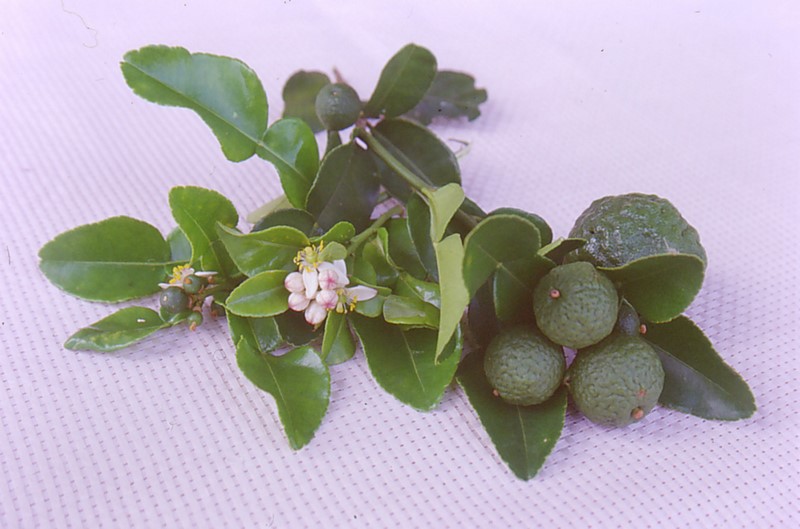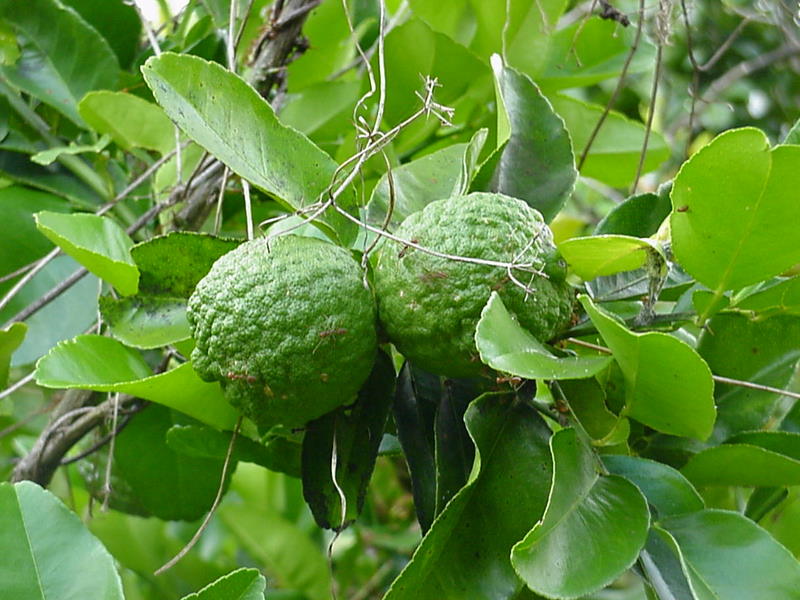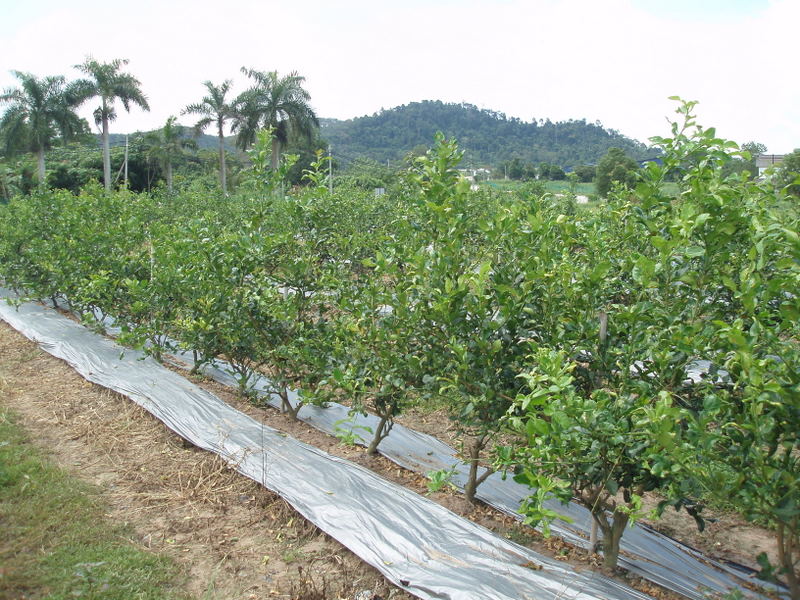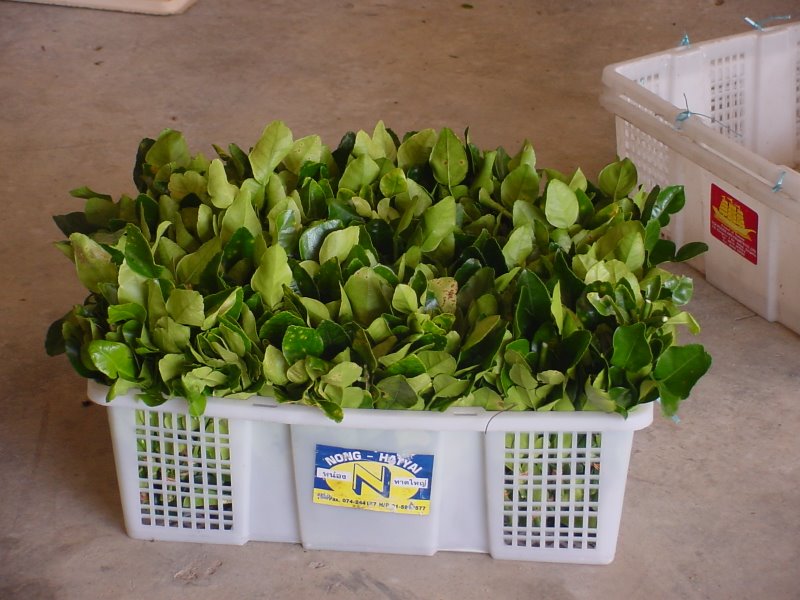Botanical Names
Citrus hystrix DC
Common Names
| Malaysia | Limau purut. |
| English | Kaffir lime, keiffer lime. |
| Indonesia | Jeruk purut, jeruk limo, jeruk obat. |
| Philippines | Swangi. |
| Thailand | Makrut, bai makrut. |
| China | Fatt-fung-kam. |
| Laos | Makgeehoot. |
| Cambodia | Krauch soeuch. |
Family
Rutaceae
Introduction
’Limau purut’ is native to Southeast Asian countries. It is normally planted around the house or in the backyard mainly for its aromatic leaves which are commonly used for Malay, Indonesian, Cambodian and Thai cooking. Both the leaves and fruits are also used for cleansing as well as in herbal preparations.[1]

Morphological Features
The plant can grow up to 30 m tall. However with frequent pruning, the plant can be maintained at manageable height for easy harvest of leaves and fruits. The leaf has a unique feature whereby the petiole is winged making it looked as if two leaves are fused together. It is dark green with a glossy sheen. The leaves are 5–8 cm long. The fruits are about the size of a western lime and are also dark green with a bumpy surface. The fruits produce little or no juice.[1]


Medicinal Properties and Usage
‘Limau purut’ leaves are said to have antihistamine, antidandruff, antispasmodic and hypotensive activities. In addition to steam bath, leaves are also used as shampoo especially for dandruff treatment. The fruit juice is said can promote gum health and can be used for brushing teeth. Essential oil extracted from the leaves are used as flavouring agents and added in cosmeceutical products such as soaps and lotions.[1][2][3]
Soil Suitability and Climatic Requirement
’Limau purut’ is very adaptable and can be cultivated on various soil types from the lowland up to about 400 m above sea level with temperature range of 25–38oC. Optimum soil pH is about 6. The plants require 5-6 months of wet season for optimum growth. The area suitable for ‘limau purut’ cultivation must have good drainage with water table at about 50 cm below soil surface during rainy season. The plants perform well in open area with full sunlight.[1]
Field Preparation
Land Preparation
Area for ‘limau purut’ cultivation should be cleared of all vegetation to prevent disease infections. Planting holes (0.6 m x 0.6 m x 0.6 m) are prepared and 100 g each of organic fertiliser, lime and triple super phosphate are mixed with top soil in the planting holes two weeks before planting. Normal planting distance used is 2.4 m between plants and 3 m between rows giving a population density of 1,380 plants/ha.[1]
Production of Planting Materials
Grafted seedling using resistant root stocks are normally used as planting materials. Vegetative propagation and seedlings produced from seeds are seldom used as prevention against infections of root rot and virus diseases and root knot nematode infestations. Seedlings obtained from private nurseries should be properly selected to make sure they are healthy and disease-free. Seedlings are ready for planting when they are about 60 cm tall. One to two weeks before field planting, seedlings should be exposed to hardening process to reduce transplanting stress.[1]
Field Planting
Branch and root pruning are conducted before seedlings are planted in the field. Mulch in the form of coconut leaves or rice straws should be provided for each plant after transplanting. However care should be taken to prevent direct contact between mulches and the seedling. Supplemented irrigation is required if transplanting is done during the dry season. Irrigation is required during the dry season for the first two years after transplanting. Plants should be inspected at regular intervals. Dead and unhealthy plants should be uprooted and transplanted with new seedlings.[1]

Field Maintenance
Fertilisation
Urea at the rate of 5 g/plant is applied at monthly intervals until the plants are 1 year old. Organic fertiliser such as chicken manure at the rate of 5 kg/plant is also given twice a year. During the second year, urea is applied twice a year at the rate of 50 g/plant. Application of compound fertiliser (N:P:K=15:15:15) is alternated with urea and applied at the rate of 50 g/plant. Fertiliser rate is increased accordingly until the fifth year when the rate of compound fertiliser used is 700 g/plant and applied twice a year.[1]
Pruning
Scheduled pruning is essential to train and develop proper branching of the plant as well as to remove dead and unhealthy branches. Pruning is conducted once a year before the onset of the rainy season. Major pruning is on the fifth and tenth year to maintain plant height at about 2 m for easy harvesting.[1]
Weed Control
Weeds are controlled by spraying two rounds of contact herbicide and one application of systemic herbicide. Manual weeding using bush cutter is another option for weed management.[1]
Water Management
For maintaining optimum crop growth, supplementary irrigation system is needed to provide optimum water supply to the crop during the dry season. Both the sprinkler and rain-gun irrigation system are suitable for ‘limau purut’.[1]
Pest and Disease Control
Leaf-miner, Phyllocnistis citrella, is occasionally found attacking the leaves. Infestation is normally low and does not need control measure. Canker, caused by the bacteria, Xanthomonas campestris var citri, can cause serious damage. Canker is controlled by pruning and defoliating heavily infected plants.[1]
Harvesting
Economic harvests of leaves are normally achieved 5 years after planting with an estimated annual yield of 4.5 t fresh leaves/ha. Harvesting is done at 3-4 months intervals. At a recovery rate of 0.8%, the leaves can produce about 36 litres of essential oil (after steam distillation) per year.[1]

Postharvest Handling
Leaves are marketed fresh for culinary purposes. Fresh leaves are also used for essential oil extraction. However, for other uses such as for preparation of traditional medicines and for steam bath, leaves can be air or oven-dried.[1]
Estimated Cost Of Production
The estimated cost of production for the first year, crop establishment period (year 2 and 3) and fully grown crop (year 4 and above) is RM24,000, RM5,700 and RM9,800 respectively. Based on the fresh yield of about 4.5 t/ha from the fully established crop, the production cost of fresh leaf is about RM2.20/kg. The production cost was estimated based on the cost of current inputs during writing of this article.[1]
Read More
References
- Yahaya, H. and Ahmad Puat, N. (2005). Limau purut (Citrus hystrix). In: Penanaman tumbuhan ubatan & beraroma. (Musa, Y., Muhammad Ghawas, M. and Mansor, P., ed.). Pg. 108-117, Serdang: MARDI
- Anon. 2002. Compendium of Medicinal Plants Used in Malaysia (Vol. 1) Pg 194, Kuala Lumpur : HMRC-IMR
- Kamarudin Mat-Salleh and Latiff, A. (editor). 2002. Tumbuhan Ubatan Malaysia. Pg. 470, Kuala Lumpur : UKM
